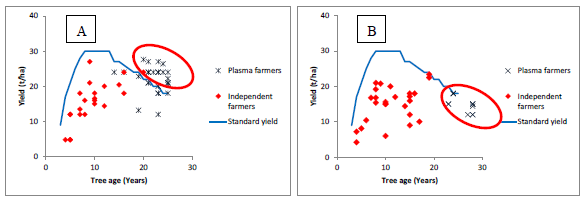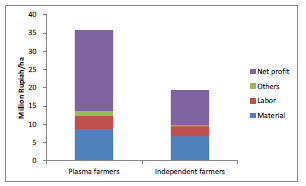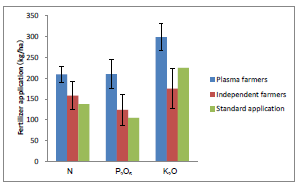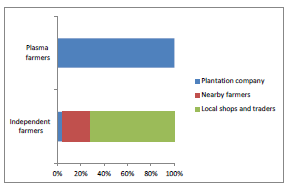Impacts of the oil palm development program in Indonesia on small scale farmers
Description
Since 1977, the Indonesian government has been implementing an oil palm development scheme called the Nuclear Estate Smallholders (NES) program. The program aims to share the benefit of plantation development between palm oil companies and rural communities by allocating a part of the plantation to small scale farmers (hereinafter referred to as ‘plasma farmers’). Under the NES program, the company is also responsible for supporting the plasma farmers through various activities, such as providing soft loans and technical support as well as purchasing fresh fruit bunch (FFB) from farmers at a guaranteed price. Although there are significant differences in the level of performance from one NES case to another, it is difficult to evaluate because of a lack of indicators. Recently, the number of small scale farmers called ‘independent farmers,’ referring to those who don’t join any collaboration programs with companies, is increasing in Indonesia, especially in Sumatera Island. This study aimed to identify the effects of the NES program by comparing the FFB production of plasma farmers and independent farmers based on the survey results about farm household economies.
Tree age of oil palm strongly affects FFB yield. In general, the yield gradually decreases after achieving highest yield between the tree ages of 8 and 13 years. In the NES case of Company A in Riau Province, some plasma farmers were able to maintain or improve FFB yield even with trees aged 20 years or more (Fig. 1A). Such high yields in older trees were not observed in the NES case of Company B (Fig. 1B). From the graph, it can be seen that the net profit of plasma farmers in CompanyA was significantly higher than those of independent farmers (Fig. 2).
It must also be noted that the amount of fertilizer application by plasma farmers was higher than the amount applied by independent farmers. The amount of potassium fertilizer applied by independent farmers was particularly lower than the standard fertilizer application rate (Fig. 3). Applying the appropriate amount of fertilizer has contributed to better yield for plasma farmers.
While all plasma farmers planted high quality seedlings with certification provided by CompanyA, most independent farmers purchased seedlings without any quality assurance from local shops or nearby farmers (Fig. 4). Clearly, the quality of seedlings was another factor affecting FFB yield. Other factors that have contributed to higher yield by plasma farmers include continuous technical assistance, Company A’s attitude towards the plasma farmers (e.g., fulfillment of contracts), and Company A’s higher dependency on plasma farmers as a source of FFB for their palm oil mill.
The above findings can be used by local administrative agencies to formulate yield improvement policies that would benefit small scale oil palm farmers.
Figure, table
-
Fig. 1. Relationship between tree age and fresh fruit bunch (FFB) yield (left: Company A case study, right: CompanyB case study).
The standard yield shows the general relationship between tree age and FFB yield as reported by Adlin (1990). In the Company A case study, some of the plasma farmers maintained or improved FFB yield in spite of the higher tree age of 20 years or more (circled in red). -
Fig. 2. FFB production cost and profit (Company A case study)
Cost and profit numbers were averaged for 26 plasma farmers and 22 independent farmers. Significant differences were observed in net profit (significant level: 1%), other cost (1%), labor cost (5%) and material cost (5%). -
Fig. 3. Fertilizer application by farmers (Company A case study)
Percentages were averaged for 12 plasma farmers and 8 independent farmers.
The error bars show the standard errors. -
Fig. 4. Source of oil palm seedlings (Company A case study)
Number of respondents: 27 plasma farmers and 25 independent farmers
- Affiliation
-
Japan International Research Center for Agricultural Sciences Research Strategy Office
- Classification
-
Research
- Program name
- Term of research
-
FY 2013 (FY 2011-FY 2013)
- Responsible researcher
-
Sugino Tomohide ( Research Strategy Office )
- ほか
- Publication, etc.
-
Sugino, et al.(2013) Journal of rural economics. Special issue, Proceedings of annual Conference of the Agricultural Economics Society of Japan, 2013: 319-326
Sugino, et al.(2014) Journal of rural economics. Special issue, Proceedings of annual Conference of the Agricultural Economics Society of Japan, 2014: 242-247
- Japanese PDF
-
2014_C06_A3_ja.pdf227.48 KB
2014_C06_A4_ja.pdf330.29 KB
- English PDF
-
2014_C06_A3_en.pdf129.88 KB
2014_C06_A4_en.pdf190.67 KB
- Poster PDF
-
2014_C06_poster.pdf277.44 KB




